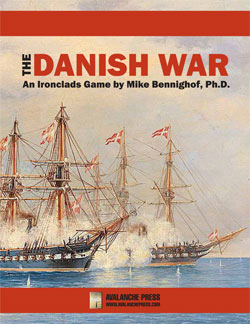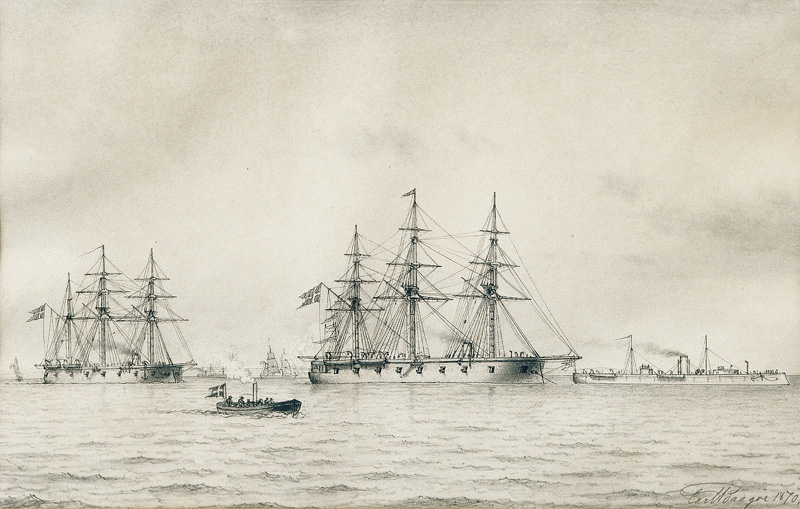| The Danish War:
The Danish Ironclad Fleet
By Mike Bennighof, Ph.D.
June 2024
 Though a small nation, Denmark has a long and violent military history. Danish Vikings invaded and conquered much of England in the 10th century, and through the late Middle Ages and in the 17th century the kingdom remained a military force with which to reckon. But foolish involvement in the Thirty Years’ War, bloody wars with Poland and Sweden, and loss of her hold on the entrances to the Baltic Sea all eroded Danish power. Though a small nation, Denmark has a long and violent military history. Danish Vikings invaded and conquered much of England in the 10th century, and through the late Middle Ages and in the 17th century the kingdom remained a military force with which to reckon. But foolish involvement in the Thirty Years’ War, bloody wars with Poland and Sweden, and loss of her hold on the entrances to the Baltic Sea all eroded Danish power.
British sneak attacks in 1800 and 1807 destroyed almost the entire Danish fleet – in almost the exact same manner that the Danes had exterminated Polish sea power in 1636. The years that followed showed little promise for a naval revival until 1841, when two modern paddle steamers were acquired from British shipyards. Three years later, the Danish Navy commissioned the kingdom’s first locally-built steamship.
The 1848-1850 Schleswig War showed the Danes that their navy had not recovered. On 5 April 1849, a powerful Danish squadron approached the Prussian/Holstein batteries at Eckernfjorde, just northwest of Kiel. Despite bringing along two of the paddle steamers to help position the sailing warships, the ship of the line Christian VIII drifted within close range of the shore and the Prussians poured red-hot shot into her. She exploded spectacularly, while meanwhile the frigate Gefion drifted onto the shore and became stuck fast; she was captured and became the core of a new Prussian Navy.
The Danes rebuilt slowly through the 1850s, laying down a ship of the line and a frigate to replace those lost at Eckernfjorde. These were conventional ships, though of fine design, powered solely by sails. But the Danish experience of 1849 cried out for steam power to save future vessels from the same fate, and Denmark’s experiment with John Ericsson’s revolutionary screw propulsion began with the 12-gun screw corvette Thor, launched at Copenhagen's Royal Dockyard in 1851.

Niels Juel’s gunners at work during the Battle of Helgoland. 9 May 1864.
Designed by the Danish Navy’s “Master Builder,” Otto Friedrich Suenson, Thor was one of the world’s earliest screw warships. Like other ships of her type, she was a standard sail-powered warship fitted with an engine and a screw propeller. Powered by a British-made 650 horsepower steam engine, she could make 9 knots under steam power and carried a full ship rig as well. Two near-sisters followed, Heimdall and Dagmar, both also built at the Royal Dockyard. Engines progressively grew slightly smaller and speeds climbed slightly higher as engine efficiency improved.
With Thor proven successful, Suenson moved on to a larger version, the screw frigate Niels Juel. She carried 42 smoothbore 30-pounders, later altered to 30 smoothbores and a dozen smaller but much deadlier rifled cannon. She was launched in 1855 and commissioned the next year, and considered successful enough that three sisters were ordered. Sjaelland was laid down five months after Niels Juel but launched two years after her sister, while Jylland was laid down in 1857 and launched in 1860. The fourth ship would be completed to a different design.
The slightly smaller sailing frigate Tordenskjold had been launched a year before Niels Juel was laid down, and in 1861 she returned to the Royal Dockyard for rebuilding. Unlike some other navies' conversions, she was not lengthened, and the 200 horsepower Swedish-built steam engine fitted to her was much less powerful than Sjaelland’s massive 1200 horsepower plant. Consequently, she was slower than the purpose-built screw frigates. Originally built to carry 44 30-pounder smoothbores, during her rebuilding she was armed with a pair of 60-pounder smoothbores, 14 30-pounder smoothbores and sixteen 18-pounder rifles, giving her the most powerful broadside of the four frigates.
Four other sailing frigates – Thetis, Rota, Havfruen and Bellona – were older ships and inspection found them not capable of supporting the added weight and stress of screw conversion.
The Danish fleet included four sailing ships of the line, two of which were older 84-gun ships declared unfit for conversion. The 25-year-old Skjold, a 64-gun ship, went to the Royal Dockyard in 1858 for her conversion. She emerged with a domestically produced 300 horsepower engine that gave her a surprising 9.7 knots, as fast as the best of the frigates.
The best of the ships of the line, Dannebrog, was a 72-gun ship launched in 1850 at Nyholm Dockyard in Copenhagen. Returned there in 1862 for conversion to screw, the dockyard’s engineers suggested a much more radical conversion, cutting her down by one gun deck like a “razee” frigate of 50 years previously and fitting her with 4 1/2 inches of armor. She emerged as a powerful armored frigate, with sixteen 60-pound rifled guns and a 1,150-horsepower engine to give her a speed of 8.7 knots.

Dannebrog before her conversion.
Repeated war scares helped give the program impetus. Denmark remained neutral in the 1853-54 Crimean War, despite pressure from both sides to join the conflict. The Navy mobilized and found its sailing warships inadequate when compared to the huge fleet of British and French screw-powered ships of the line that steamed past to attack the Russian fortress of Bomarsund. And in 1855 came a war scare with the United States, as the Americans refused to pay the traditional toll to pass through the Sound, the strait between the Danish islands and Swedish mainland. Tolls had been paid since 1427, when the strait was still an inland Danish waterway, and had continued to be exacted even after the opposite shore fell into Swedish hands. When the Americans threatened war, the Danes considered defending their rights by force but eventually backed down, accepting a one-time cash payment in exchange for free navigation.
Though willing to fight the Americans, the Danes knew their real enemy lay to the south, and they labored to make sure their Navy remained superior to the combined seapower of the two leading states of the German Confederation, Prussia and Austria. With Austria laying down her first ironclads in early 1861, the Danes knew they had to match them and Dannebrog would not be enough.
The fourth ship of the Niels Juel class, Peder Skram, had been laid down at Nyholm in 1858. She underwent a conversion similar to Dannebrog's starting in 1862, receiving a much more powerful 1,600 horsepower engine that made her the fastest of the Danish warships at 11.5 knots. She also had 4-1/2 inches of armor, and carried six rifled 60-pounders and eight rifled 24-pounders.

Armored frigate Peder Skram, center, seen in 1870. Dannebrog (as converted) to the left, and the turret ship Lindormen to the right.
Danish resources could not supply all of the fleet's needs, and the Navy began to cast about for foreign vessels. With the Confederate States Navy's indefatigable Stephen Mallory sending agents all over Europe in search of modern warships, prices had skyrocketed in a seller's market. The Danes purchased two small armored gunboats were purchased in 1862 from a British shipyard, named Absalom and Esbern Snare. The next year they added the 1,300-ton armored turret ship Rolf Krake, a sea-going monitor ordered by the Danes from Napier and Sons in Glasgow.
Named for a mythical Danish hero, Rolf Krake was the first warship to mount the patented “Coles turret.” The armored turret’s weight was borne by a circular race rather than a center pivot like the monitors of the American Civil War. Two turrets each mounted a pair of 68-pound smoothbores.

Rolf Krake shells the Prussians at Duppel, April 1864.
She was a nimble ship, and most importantly for the Danes drew only 10 and a half feet of water, enabling her to maneuver in Denmark's archipelago of islands and provide fire support to troops ashore while avoiding another Eckernfjorde disaster. She would prove the most useful of the Danish ironclads when the war the Navy believed inevitable broke out in 1864.
Click here to join the Gold Club
See your Gold Club Insider newsletter for ordering information.
Sign up for our newsletter right here. Your info will never be sold or transferred; we'll just use it to update you on new games and new offers.
Mike Bennighof is president of Avalanche Press and holds a doctorate in history from Emory University. A Fulbright Scholar and NASA Journalist in Space finalist, he has published a great many books, games and articles on historical subjects; people are saying that some of them are actually good.
He lives in Birmingham, Alabama with his wife and three children. He will never forget his Iron Dog, Leopold. Leopold needed no revisions.
Want to keep Daily Content free of third-party ads? You can send us some love (and cash) through this link right here. |
